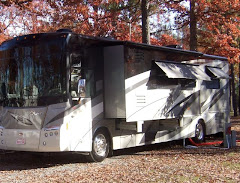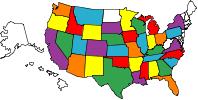
We left the scenic surroundings of the Texas Mountains yesterday and headed north through miles and miles of vast nothingness into New Mexico. (We followed that fifth wheel most of the way!)
The first real town we passed through after crossing the state line was Loving, which made us think of our friends Cindy and Rick. This one's for you two. Cheers!
We made our way through the town of Carlsbad to the KOA several miles north of town. The sites are spacious and flat. Bullwinkle especially likes being level, for a change.
Our primary purpose for stopping in Carlsbad was to visit Carlsbad Caverns National Park, which is about 20 miles south of town. After making the turn off the highway and toward the caverns, we were pleased to see something scenic once again. (Yes, when you are in southeast New Mexico, this is scenic!)
At the visitor's center, we flashed our annual park pass and picked up two audio tours. (We highly recommend!) When the ranger asked if we wanted to walk or ride down, we told him we'd rather hike. So, he pointed us toward the trailhead. Along the way we saw several warnings about the 1.25-mile hike ahead of us.
We came prepared for this downhill hike and didn't have any doubts that we could make it safely. But, as the warnings became more serious, we started to wonder!
As experienced hikers, we really weren't worried. This is the last sign you see before you stop and check-in with a ranger who gives you clearance to move on. He looked us over and gave us a few last minute words of advice. With that, we were ready to go.
Just outside the Natural Entrance is a large amphitheater where visitors come for the nightly bat flight. Each evening at dusk, thousands of Mexican free-tailed bats fly from out of the entrance to the cave. Lucky for one of us, this nightly show doesn't begin until late Spring. Today we would not be sharing the cave with any bats!
Now would be a good time to tell you that the same one of us who is glad there are no bats here is really not terribly fond of caves. (And, it was my idea to come here!) With camera in hand, and Paul leading the way, I began the 750-foot decent while keeping a sharp eye back on the entrance and the great outdoors.
Before long, we entered what is called "The Twilight Zone". In this space, there's very little daylight still entering the cave. An eerie cloud of mist covers the entrance, which suddenly seemed very far away.
We stepped ahead in the darkness and were glad to see plenty of lights to show us the way. Though the trail was steep in places, there were helpful handrails along the way. For the one of us who isn't too fond of caves, the trail was quite spacious. This was one of the most narrow spots along the way. We (er, I) never felt closed in.
Along the way, I took hundreds of really bad pictures. Because we were hiking (and you saw all of those warnings!), we left our nifty Nikon and tripod at home. So, I did the best I could with my little "point and shoot" and wasted a bunch of zeros and ones. A few did come out well enough to give you a taste of our underground hike.
Our audio tour provided lots of interesting and helpful background about the wonders of the cavern. Now we can remember that stalactites "grow" from the ceiling and stalagmites live on the floor. When these two meet somewhere in the middle, they become a column. The audio tour also answered key questions, such as "Do these things ever fall?" and "Is there plenty of fresh air in here?" just about the time one of us was wondering about such things. (The answers: No and Yes.)
The nice paved trail we were hiking on followed the original explorer's route into the cave. The trail, of course, is a relatively recent addition. Early visitors to the park were lowered into the cave in some kind of cabled contraption, and then walked down these steep wooden stairs. I much prefer the route we took today!
The cave decorations, as they are called, didn't photograph well but they were amazing. These kernel-like decorations are aptly referred to as "popcorn".
When we reached the end of the Natural Entrance trail, things leveled out a bit and we made our way along the 1.25-mile trail that circles the Big Room. This 8.2 acre "room" is highly decorated and immense.
This wire ladder was used by a National Geographic team in 1924 to explore a lower cave. We're not planning to be a part of any National Geographic teams any time soon!
Dripping water is the sound of a live cave. By the sound and feel of our visit today, this cave is very active! The cave pools were fascinating. This rainwater traveled a very long distance to get here.
As we headed toward the elevator, we saw a couple of photographers with fancy cameras and tripods getting a shot of this "Doll's Theater" decoration. I bravely walked up, held my breath, and snapped. It didn't turn out half bad.
With our 2.5-mile awesome hike complete, we hopped on a waiting elevator and took the one-minute ride back to the surface. As we made our way back to the moose, we took in the vast, flat nothingness of southeast New Mexico with new eyes. When you come to Carlsbad, you have to go underground to find the scenic wonders. They are something to see.
And, that's coming from somebody who wasn't fond of caves. Until today.























































